
copyright 2008 by George Johnson
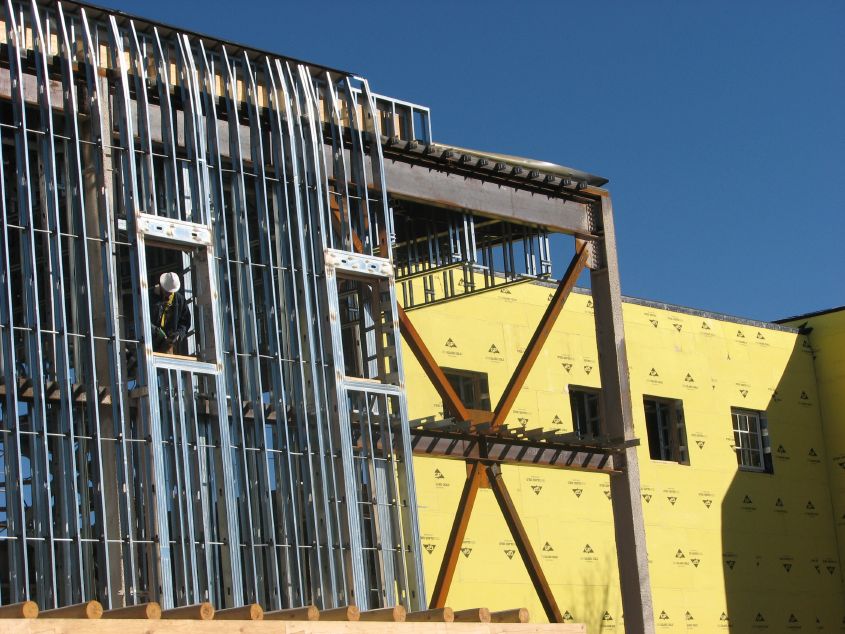
Santa Fe Style: The Civic Center, photo by George Johnson, copyright 2008
1. Retrofit Arithmetic (and Rainbarrel Economics)
2. The San Juan-Chama Shell Game
3. The Case of the Disappearing Aquifer
4. The Creative Hydrology of Suerte del Sur
5. The City, the County, and a Water Tax Revolt
6. Water Numerology at City Hall
(Our story thus far)
7. The Woman at Otowi Gauge
8. "Forget it, Jake. It's Chinatown."
9. The Las Campanas Connection
(Our story continues)
10. The Engineering Solution
January 28, 2008
48. Festival of the Cranes
Saturday morning I drove down to Montezuma and Sandoval Streets hoping to catch a glimpse of the Old Santa Fe Association's inspired demonstration of how imposing the proposed new county courthouse will be. Parking a construction crane in a lot across the street, the association hoisted a banner 52 feet above the ground -- the exact height the courthouse would stand. City code allows for only a 21-foot structure, but the county claims an exemption.
It's the same argument the state has been making in regard to the Railrunner station and commercial building planned for its property on the corner of Cerrillos and Cordova: As a higher governmental entity, it is supposedly beyond the reach of municipal control. I've never understood how that could be. Surely county and state employees driving around town on government business must put quarters in city parking meters and obey traffic laws. If the exemption is limited solely to land use codes would the county be allowed to demolish its offices on Grant Street and lease the site to Richard Cook for a gravel quarry?

I arrived too late to see the crane -- it was lowering its boom and preparing for its return to Tony's Rentals. Walking over to the abandoned Blue Monkey building, I peered through the windows at the vandalism and violent obscenities. The whole block, all the way to the river, is starting to look like a blighted area. Judging from the grounds in front of the Blue Monkey, the county also considers itself exempt from local litter and weed ordinances. And the state continues to ignore the city law requiring the timely removal of graffiti -- on the Labor Department building and even on the official state historical marker at De Vargas Park. What disappointing neighbors these are.
In the distance I could see the mother of all construction cranes looming over the site of the state's new history museum on Lincoln Avenue, an eternal work in progress. I read in Sunday's New Mexican that a smaller crane, for concrete pumping, had toppled there on Saturday and smashed a parked car. Across Lincoln another enormous construction/demolition project is commencing at the abandoned La Esquina Building, catty-corner from the rising yellow hulk of the new convention center -- all of that within a radius of one block. Before it all is done, construction may well begin on the Archdiocese development and, on the other side of Cathedral Place, an expansive new addition to Loretto Inn. And there will be the conversion of the old hospital on East Palace into a Drury Inn hotel. And the proposed high-rise Jim Kirkpatrick wants to shoehorn between La Fonda and Loretto Chapel . . . Cranes will be rearing their heads all around the plaza for years to come.

The first round of election financial reports was posted last week, reinforcing the impression that Martin Lujan's campaign will be a Carmichael Dominguez rerun: a school board member from the West Side (or wherever Mr. Lujan actually lives) presenting himself as a populist while getting most of his backing from construction and real estate interests. There is $500 from Garrett Thornburg, $200 from Christopher Ihlefeld, a Thornburg fund manager, $150 from the Thornburg companies' chief spokesman, David Miller, and another $500 from Thornburg Mortgage board member Owen Lopez (who is also executive director of the McCune Foundation). The next big cluster comes from developers involved in the Railyard project: $400 each from real estate broker Allen Branch and his business partners, Rick Jaramillo and Marco Gonzales, and another $400 from Camino Real on the Railyard LLC. In addition there is $600 from Harris Consultants, which manages construction projects for the Santa Fe Public Schools and the Railyard Park and Plaza (the noncommercial portion).
Mr. Lujan's biggest contributor at $900 is Thomas Dillenberg, a real estate investor and co-owner with his wife, Judith, of the Clay Angel pottery store downtown. Add in the donations from Pacheco Development, City Mortgage, Morris Surveying and Engineering, and other construction-related businesses and the total comes to at least 60 percent of Mr. Lujan's war chest. Much of the rest is from family members.
(As revealing as where the money came from is how it is being spent -- $400 to Eli Senna. If the name doesn't ring a bell, please run it through the search box below.)
In District 2, it's no surprise that Robbie Dobyns is getting almost all of his backing from his realtor colleagues -- $2,410 from the Realtors Association of New Mexico's political action committee and $1,500 from his own company, Santa Fe Realty Partners.

Several years ago Robin McKinney Martin, who inherited the New Mexican from her father, took me to lunch at The Shed. Though I had written her a long letter presumptuously laying out what I thought was wrong with her paper, she graciously insisted on picking up the check. It was clear as we ate our enchiladas that what she really wanted to talk about was not journalism but geology.
Last Sunday Ms. Martin's love for the subject shone through in a fascinating package of articles about oil and gas in the Galisteo Basin. I was reminded that people too -- our bodies and brains -- are hydrocarbons. Someday, like the fish and plankton of the Cretaceous sea that once filled New Mexico, we will be tectonically crushed to our components, fuel perhaps for some future inhabitants.

Slums of Santa Fe, Part II
While we're on the subject of bad neighbors and deteriorating neighborhoods: Yesterday I drove along Acequia Madre and up Camino del Monte Sol. All of the spraypaint vandalism -- already weeks old when I reported it on January 13 -- was still there. I've inquired with the city as to whether the "Office of Anti-Graffiti Coordination" (if such a thing actually exists) followed through, as required by Ordinance 20-4.2-E1:
Elimination of Graffiti. (1) Whenever the city becomes aware of the existence of graffiti on any real property, including structures, within the city and visible from the public right-of-way or city-owned land, the office of anti-graffiti coordination shall give or cause to be given notice that the graffiti should be removed or effectively obscured within ten (10) days of notice being conveyed by the city, removal being either by the person in charge of the property or by the city or the city's agent. A reasonable, good faith effort shall be made to deliver the notice to the owner or person in charge of the property. The owner or person in charge of the property may cause the graffiti to be removed or completely obliterated; if this is that person's intent they should so advise the office of anti-graffiti coordination within ten (10) days from the time the notice is delivered if the property owner/agent will remove the graffiti within the time specified. Within a similar period, the owner/agent may advise the office that the marking identified was authorized by the owner or person in charge of the property and thus is not graffiti as herein defined; the city will then not authorize removal.
In any case the property owners have shown such disregard for the community that I think it's fair to post their names along with my earlier photos. There are some you might recognize.
February 1, 2008
For a few tense minutes at Wednesday's Council meeting, it appeared that Matthew Ortiz was about to show something resembling statesmanship. As the councilors, one by one, addressed Rebecca Wurzburger's latest transmogrification of the bill to legalize short-term rentals, the night was clearly leaning her way. Councilors Calvert and Dominguez were in the bag. And Miguel Chavez had unexpectedly caved, dropping his insistence on a five-year phase-out in return for a toothless amendment involving Neighborhood Conservation Districts, hypothetical entities that may or may not ever come to exist. Then it was Councilor Ortiz's turn.
For all his faults, Mr. Ortiz is the most intelligent and articulate of the councilors. He is also the only one with a law degree. Like a large bear emerging from a winter slumber, he launched into an uncompromising refutation of the vacuous assertion, made so many times during the public hearings, that a person has a right to do whatever he wants with his property. You obviously can't open a commercial car wash in a residential neighborhood, he reminded. Municipalities have the long-established right to regulate land use by imposing zoning laws.
As Ms. Wurzburger squirmed, her old ally went on to object to her provision grandfathering-in every single vacation rental currently in operation and suggested, as a "friendly amendment," that only those in business as of 2002 be allowed to continue.
At this point Rebecca looked as though she was about to vomit. She quickly regained her composure and smilingly deferred to Frank Katz, the city attorney, who recited the familiar litany of legal problems the 2002 date might pose. Mr. Ortiz obligingly withdrew his amendment, leaving the impression that we had been witnessing a charade.
The bill passed 5-3.
The cap of 350 doesn't mean much. By granting legal recognition to these zoning violations, the council has irreversibly shifted the fulcrum. In 18 months when the new law comes up "for review," the push will be on to raise the ceiling or to allow transient rentals to continue even after a property is sold. Various regulations and registration requirements will be deemed unreasonable or unenforceable and scrapped. Whoever wins next month's elections -- in districts 1, 2, or 3 -- it's hard to be optimistic. Unless all you see when you walk the streets of old Santa Fe are dollar signs.
February 2, 2008
A brief item in Friday's New Mexican hardly did justice to the legal challenge attorney Steven Farber is mounting against the county's belief that anything it chooses to build inside city limits is immune from local zoning codes. The argument has been repeated again and again, most recently in a Journal editorial: the county trumps the city, so its plans for a new three-story courthouse on Sandoval Street do not have to abide by the Historic Design Review Board. If it wanted it could build a 40-story glass skyscraper or a Ferris wheel.
When he was a councilor, Mr. Farber pushed for expansion of the H-board's powers to include limiting building height. In a strongly worded letter, he challenges the county's contention that it is somehow exempt:
There have been comments made that the Historic Design Review Ordinance does not apply to Santa Fe County and its projects within the historic zoning districts. That is not true. There are erroneous claims that the old State Land Office pump jack case, City of Santa Fe v. Armijo, 96 N.M. 663 (1981), exempts Santa Fe County from following the requirements of the Historic Design Review Ordinance. That is a misreading of that case and its holding. Santa Fe County is bound by the City of Santa Fe Zoning ordinances, including the Historic Design and Height limitations.
For one thing. Mr. Farber writes, the 27-year-old case was limited specifically to state land. (The city and several neighborhood groups were suing to compel the New Mexico State Land Office to remove an oil pumping rig [!] it had erected downtown at its building on Old Santa Fe Trail.) Furthermore, Mr. Farber argues, changes to state law have superseded the decision, making clear that Santa Fe has zoning powers over both state and county property.
The question, as always, is whether our court-shy city government is willing to go to the mat. Here is a copy of Mr. Farber's letter with Santa Fe v. Armijo and another relevant court case attached.
February 3, 2008
Postscript
Karen Heldmeyer has sent me an email objecting to my characterization of Miguel Chavez's turnabout on short-term rentals: "Whatever it looked like from the audience, Miguel was not doing a quid-pro-quo." (Please see my dispatch of February 1.) Readers of these pages know I have great respect for Councilor Chavez, a sincere and principled man. But had he and the mayor stuck to their guns on a five-year phaseout, Wednesday night's outcome probably would have been avoided.
I say "probably" because Councilor Trujillo, who voted with Councilors Heldmeyer and Bushee against legalization, might have flipped when he saw how the tide was turning and joined the Wurzburger-Ortiz-Dominguez (a.k.a. the Santa Fe Association of Realtors/Chamber of Commerce) block. The main reason Mr. Trujillo gave for opposing Ms. Wurzburger's bill was that the grandfathering provision (requiring operators to supply past tax records) was unfair to old Santa Fe families who have been running tourist lodges off the books. Tax cheats, in other words.
But perhaps Councilor Calvert would have recovered the suppressed memory of the campaign promise he made two years ago to the Canyon Neighborhood Association -- "to ensure that the [short-term rental] law currently on the books is not weakened and that it is vigorously enforced." The mayor, let's not forget, promised the same thing.

The letters section of Sunday's New Mexican leads with the usual complaints about city services. Here, for the record, is a different perspective:
Our water meter was among the frozen during January's off-the-scale cold snap. Maybe we were lucky that it happened on the Friday before the long weekend. Within a few hours two men from the water department were out thawing the meter with a blowtorch. Despite the bitterly cold temperatures and a seemingly endless roster of work calls, they were professional, courteous, and impressively good-spirited. Because of the unprecedented demand, they had run out of insulation to cover the meter (ours has not had any in the 15 years I've lived here), so I found an old moving blanket. "Thanks! This will help a lot," one of the workers said, stuffing it down the hole and replacing the top. Then they were off to the next job.
On another front, snowplows have been out here after every major snowstorm with a promptness and efficiency I've not seen before. And the switch to weekly recycling pickup has been seamless. I'm not doubting others' bad experiences, only suggesting that they are the exception not the rule.
February 4, 2008
I just heard from Fletcher Catron, a well known local attorney, who says he believes Mr. Farber is correct that Santa Fe v. Armijo does not exempt the county from following the city's zoning laws:
As I recall it, the point of the pumpjack case was that, as a subordinate creation of the State, the City cannot bind its "superior." The County is not the superior of the City, however; rather, they are co-equal entities with full authority over the areas they govern. If one of those entities wants to build within the jurisdiction of the other, it must follow the laws of the other.
He noted, however, that neither City nor County "can impose its will on the governmental activities of the other." (My italics.)
I doubt if the City's living wage ordinance can bind the County, since control of its employees is pretty much essential to the operation of a government.
Perhaps in coming days we'll learn from the County where it got the notion that it can build its courthouse as high as it likes and that it was doing the Historic Board a favor when it submitted the plans for review.
February 7, 2008
La Villa Real de la Santa Fé de San Francisco de Graffiti
Walking back from my polling place Wednesday afternoon, I was glad to see that the spraypaint scribbles on Acequia Madre Street had been erased.
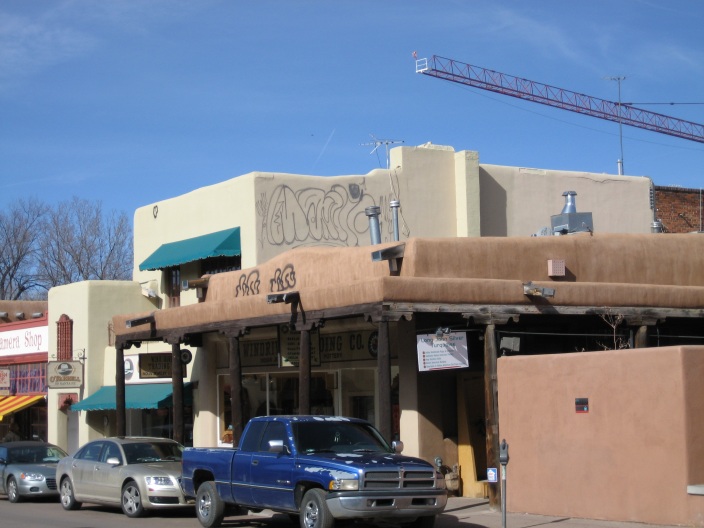
The graffiti goons are more resourceful. Earlier that morning I saw new tags on buildings along Palace Avenue, including the Palace of the Governors, and old ones on East San Francisco Street. Vandalism I reported two months ago on various light poles and utility boxes -- easily wiped off with a rag and solvent -- continues to be ignored.
Meanwhile nearly 10 days have passed since I asked the city for the following information:
(1) a copy of the standard letter that the Office of Graffiti Coordination sends property owners to notify them of a graffiti complaint (2) a copy of the most recent semi-annual report that the same office is required to make to the Council (20-4.2-D) and (3) an accounting of how many such letters were sent out in 2007
Laura Banish, the city's first-rate public information officer, immediately responded and directed my query to the Parks Department and City Clerk. And that is where it lies. A couple of days ago I received a letter from the clerk's office saying that it needed more time to fulfill my request.
Maybe I'm being too pessimistic but I expect the response to be (1) what standard letter? (2) what semi-annual report? and (3) zero.
February 10, 2008
Thornburg Watch
Last week in a 53-page opinion (you can download a copy here), the New Mexico State Court of Appeals upheld what neighbors of the Thornburg Companies' new headquarters in northwest Santa Fe have been saying all along: that they have a right to enforce covenants requiring that commercial development in the area be characterized by small shops (restaurants, groceries, and so forth) and conform to Santa Fe architectural style.
Thornburg, of course, is well on its way toward completing, with a tax break from the city, a modernistic 100,000-square-foot office complex. (For background please see The Thornburg Dilemma, The Dempsey Papers, and Trojan Horse Trading.)
So far the newspapers haven't picked up on the story, and Thornburg stock has been slowly recovering from another slump. Recently the price had fallen back to just a few pennies a share above the rock-bottom $8 I paid in August. (Please see Before the Fall.) On Friday it closed at $13.12.

February 12, 2008
Kiera Hay has a good piece in the Journal this morning putting the Court of Appeals ruling into perspective, but I wonder if she and her editors are overly credulous of the claim (by the developer, Santa Fe Estates) that the court's decision is irrelevant. After all, it was Santa Fe Estates that filed -- and has now lost -- the appeal. Had the ruling gone the other way, the company would presumably be touting it as a victory.
Ms. Hay reminds us that other litigation is pending that will determine whether Concerned Residents of Santa Fe North has legal standing to pursue the matter. But even if it doesn't, home owners in the area presumably could band together and seek to enforce the covenants through a class-action suit. I suppose that the most they could get at this point would be damages -- or leverage to force Mr. Thornburg to put his parking underground. Maybe we'll learn more from the New Mexican tomorrow.

February 13, 2008
After reading the New Mexican story this morning, I'm more confused than ever. The appeals court affirmed the right of the neighborhood group "to enforce the creation and recordation of the restrictive covenants" governing commercial development in Santa Fe Estates. (This is from paragraph 6 of the decision.) But apparently there is a distinction between the right to enforce the creation and recording of a covenant and the right to enforce its enforcement. Or something. Muddying things still further is the issue of whether the covenants include all or just some of the restrictions spelled out in the Vision Statement. But even the subset that the court specifically recognized apparently includes "limitations on the style of architecture." And that, I thought, was the whole point. This is worse than quantum mechanics.
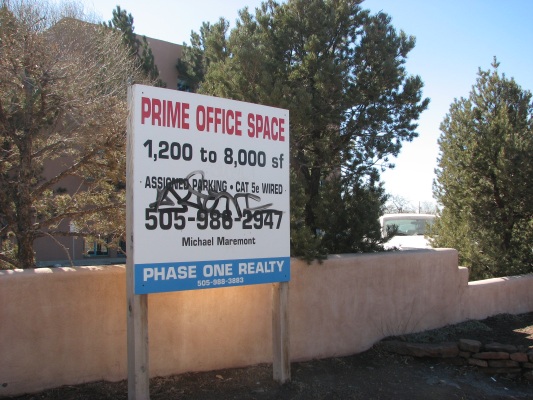
February 16, 2008
Slums of Santa Fe, Part III
It was encouraging to read in yesterday's papers that an alert security guard and some good police work led to the capture of a 21-year-old vandal, who was decorating downtown with a can of red spraypaint. For Valentine's Day. It's no wonder that these sociopaths feel so emboldened. They know that in Santa Fe, especially in winter, the damage will probably be on display for months.
Speaking of which, I finally received an answer, sort of, to the query I sent the city about its graffiti-removal program. Under the state Inspection of Public Records Act, municipalities must respond to requests for information "immediately or as soon as practicable," but in no more than 15 days. True to form the city took the maximum time allowed by law to deliver the minimum possible information.
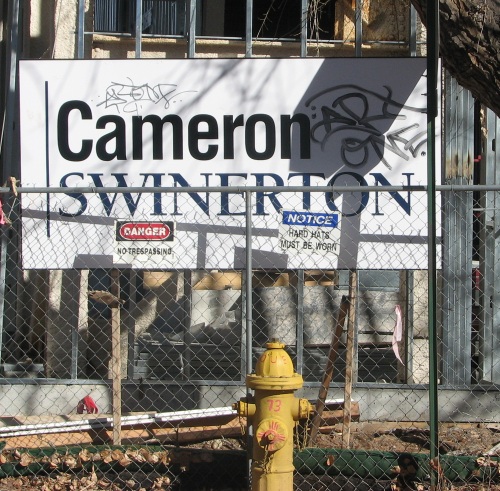
Most of the response consisted of a memo written in December tallying how many times graffiti was removed in 2007 and a copy of the graffiti ordinance, which I already had. Why that would take 15 days is beyond me. Maybe the municipal Xerox machine broke.
The memo noted that the crews "can't paint or power wash when weather is below 35 degrees." I still don't find that entirely persuasive. Unless they figure out a method -- oil-based paint? sandblasting? what do they do in Boston or New York? -- the city is surrendering territory to the goons.
Finally I was informed that the Graffiti Office doesn't send letters to owners of vandalized property but rather a copy of the ordinance. Good enough, I guess, but no one could tell me how often, if ever, this is actually done. My most pressing question went unanswered -- when and whether the property owners along Camino del Monte Sol ever received notices.
This morning I saw that half the tags have still not been removed, despite the warmer weather. (Nor have those downtown on the Wind River Trading Company and O'Farrell Hats.) Those remaining include:
The final case is particularly aggravating. It was reported to the city on December 17 -- two months ago. Since then the house has undergone remodeling -- by Building Adventures Unlimited, the company owned by Boni Armijo, who grew up in the neighborhood (his family owns Johnny's Cash Store) and sits on the Planning Commission. Surely he has the resources and the civic spirit to have the tag removed.
I just don't get it. Why would Cameron Swinerton, the company building Santa Fe (Convention) Center, leave its sign at Marcy and Griffin covered with graffiti for months? And why wouldn't the city object? A block away a sign at Lincoln Place, managed by Branch Realty, has been covered with graffiti since time immemorial, as has a sign on Paseo de Peralta for Phase One Realty, developer of Santa Fe Estates.
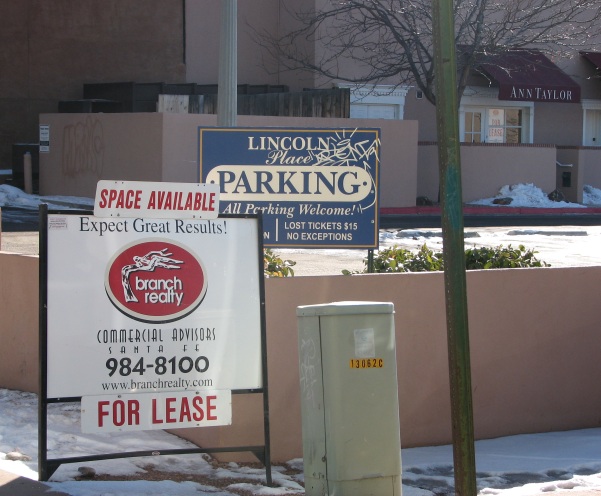
February 28, 2008
On my way to Dragoon, Arizona, where I spent the early part of this week at an Amerind symposium on the disappearance of the Anasazi, I stopped in Los Lunas for lunch and to check my email. Courtesy of the municipal government, wireless Internet pervades the village, and I was easily able to lock onto a signal at the public library. Sixty miles farther south I tried again, just for fun, in Socorro. No problem. The town plaza is also connected. Standing on the gazebo, communicating with the outside world, I thought about how far behind we are in poor, benighted Santa Fe.
Just before I left on this road trip, the New Mexican reported that municipal wifi has been delayed once again by the tiny cult of technophobes I've written about before (here, here, and here). The plan to join the rest of the developed world and provide this service finally made its way to the Public Works Committee, where Patti Bushee tabled it (at the request of some fiction called the Santa Fe Alliance for Health and Safety) until after next week's Council elections.

February 29, 2008
When I drive around the West it's with an eye toward finding Shangri-La -- a hidden place with all of Santa Fe's charms but without its frustrations. Bisbee, with its Victorian buildings, glowing copperlike in the morning sun, is almost a contender. The winding streets and tall staircases, climbing up to cottages wedged against the canyon walls, give the place an Old World air, like Deadwood crossed with a Provencal hill town.
The Copper Queen, where I stayed, is the local La Fonda, with two or three good restaurants nearby. Some even offered local wines. What Bisbee lacks is the critical mass of culture (correlated with the critical mass of money) that gives rise to things like the Santa Fe Opera and the Santa Fe Symphony and Chorus, the Chamber Music Festival and the Desert Chorale. All Bisbee had to offer was a dinner theater with an amateur production of "Annie Get Your Gun."
The nearest thing to a city, Sierra Vista, is a nightmarish grid of strip malls and chain stores, and Tucson is far away. Yesterday morning, hoping for something better, I headed for the old mining town of Patagonia, which I'd heard was an undiscovered gem. As I drove for hours on a Forest Service road, just a few miles north of the Mexican border, the grassy yellow plains reminded me of the real Patagonia, where Chile and Argentina end. But the town of Patagonia, Ariz., didn't amount to much.
Tonight I'm in Safford (not even in the running) preparing for a meeting tomorrow with some astronomers on top of Mount Graham. Then I happily head for home.
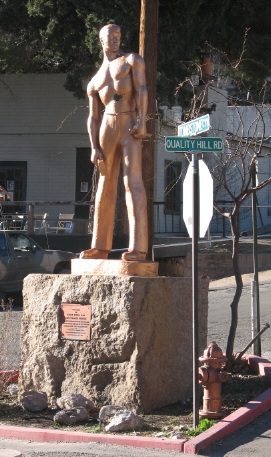
March 3, 2008
From Safford I crossed into New Mexico on Highway 78, then cut across Catron County, listening to a replay of "Prairie Home Companion" on public radio. By the time I got to Reserve the static won out, as though someone were jamming the signal. On toward Datil the only thing my radio could hear was a gospel show broadcasting in Navajo from Window Rock. As I passed a billboard advertising Promised Land Taxidermy, a single sentence in English leapt off the announcer's tongue: "Why should the devil have all the good music?"
Back in Santa Fe, the Sunday New Mexican awaited with two excellent front-page stores by Phaedra Haywood on the Galisteo drilling threat -- and the sad news that the paper is dropping the only thing worth reading in its otherwise dreadful Sunday magazine: the book review section, which has been edited with aplomb by my old college classmate and fellow author Terry England. Meanwhile the Great Shrinking Real Estate Section has all but evaporated. The housing market has apparently slowed to the point where it barely pays to advertise.
Finally there was the news today about Thornburg. When I read Bob Quick's puff piece ("Thornburg: Back in the game") about three weeks ago, I was feeling pretty good about my investment. The stock price was holding between $12 and $13, a few dollars more than I'd paid. An analyst had upgraded the company from "hold" to "buy" and set a target price of $14. If it approached $16, I told myself, I'd sell and double my money.
How quickly everything can go to hell. "Thornburg May Be Forced Out of Business," the Associated Press reported this morning. As I watched with sick fascination, the shares plunged below $4 and closed just slightly above that.

The Andrew and Sydney Davis Webcam
Santa Fe Review Detours of the Wild West
The Santa Fe Review
More links:
See the current flow of the Santa Fe River above McClure Reservoir with the USGS automated gauge.
The Otowi gauge shows the flow of the Rio Grande north of Santa Fe.
Santa Fe water information, a collection of documents and links